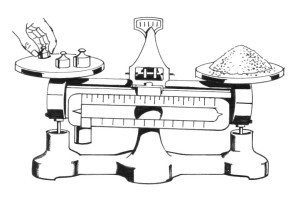
Image from Wikipedia
Balance is really important to me when it comes to game design. What is that, you say? OSR heresy! It’s true though. The principle that I operate under is that nothing should be obviously optimal or suboptimal outside of specific circumstances. Everything should require meaningful and feasible trade-offs.
The common discourse about balance is about something different, though. It usually focuses on power balance between PCs in order to facilitate spotlight sharing. In general, I assume that characters of different levels may be adventuring together (based on either PC mortality and replacement, or from new players joining the campaign). Once you assume that different level characters will be working side by side, this kind of balance goes straight out the window (and good riddance, too).
Games where, practically speaking, 2 or 3 weapons are pretty much always the best choices, are a failure in my mind (at least in that dimension). The three dart per round AD&D magic user is a really good example of this (why would they use any other weapon?), as are weapon specialization rules in virtually every game that uses them (because such rules create a structure that destroys the possibility for interesting trade-offs). (For an example of weapon specialization rules that don’t suck structurally, consider something like weapon tricks that require setup time but have interesting side effects, like entanglement or stunning.) The whole AD&D variable damage weapons system is something of a mess, because it requires so many other fiddly subsystems to be operating (weapon speed, weapon length, weapon versus armor type, damage type) in order for the whole thing to not collapse into two or three optimal choices (long sword, long bow, two-handed sword). Some people might criticize the traditional spell list in this manner too, but I believe they are misunderstanding the use of many spells.
This does lead to several interesting corollaries. First, it reinforces my desire for a logarithmic power curve. I want PCs to develop, both for interest and adventuring incentive, but broadly rather than deeply, and in a way where the top level characters don’t totally outstrip the beginning level characters. Higher level characters should have more options, and more staying power, but scary monsters should always be scary, tricks should always be tricky, and traps should always be devious. There have been good arguments made that medium and high level D&D play models a different kind of protagonist than low level play, but it seems to me that barring some cosmetic mechanical similarities, these different tiers are actually different games (or they are just smoke and mirrors using scaled difficulty mechanical illusionism). I was just in a FLAILSNAILS game where one of the PCs “outgrew” the setting because he advanced above some level. This seems like something of a flaw in the D&D level model, at least as commonly implemented.
Second, how is a great power not automatically better than a lesser power? For example, a +1 sword is in all dimensions always a better option than a mundane sword (barring something like a curse, or an angry previous owner). The answer is that a great power is not automatically better than a lesser power if it is not of unlimited use. Go ahead, give a party of first level characters a scroll of meteor swarm or time stop and watch them agonize over when to use it. Make using power cost something.


